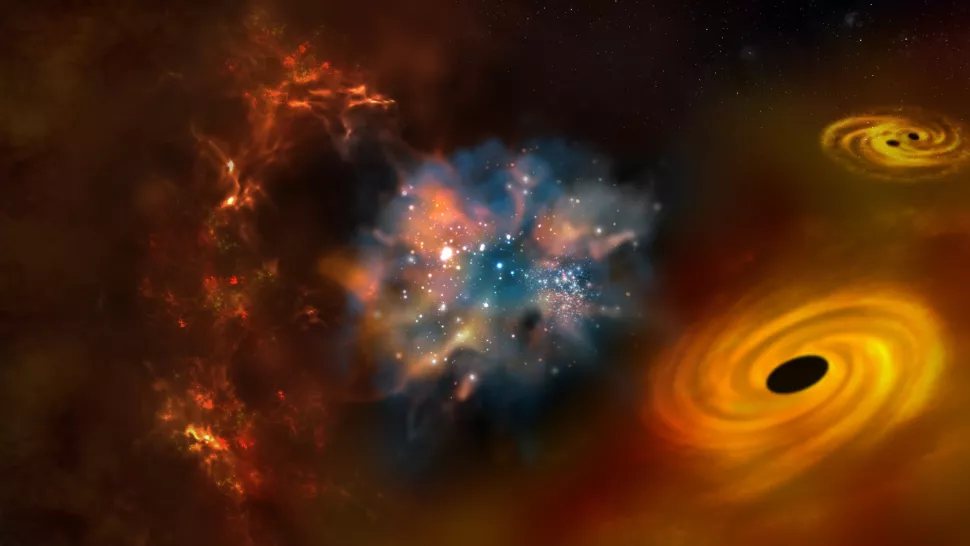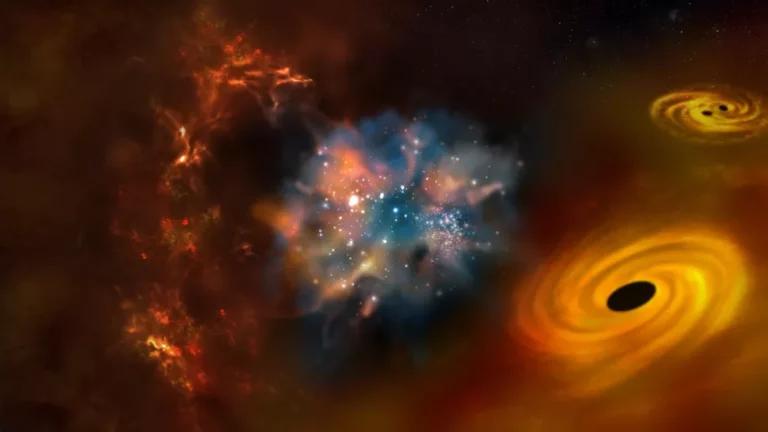A new study suggests that in the early universe, there were stars that were 10,000 times larger than our sun.
When the universe’s first stars emerged from the cosmic dark ages, they ballooned to 10,000 times the mass of Earth’s sun, new research suggests.
A recent study indicates that the initial stars in the universe could have had a mass exceeding 10,000 times that of the sun, making them approximately 1,000 times larger than the most massive stars in existence today. Currently, the largest stars have a mass of approximately 100 solar masses. However, during the early stages of the universe, enormous supergiant stars were prevalent, which lived a brief but intense life before dying out rapidly, according to the researchers.

And once these doomed giants died out, conditions were never right for them to form again.
The cosmic Dark Ages
Approximately 13 billion years ago, shortly after the Big Bang, the universe lacked stars and was instead filled with a warm, neutral gas consisting mainly of hydrogen and helium. Over millions of years, the neutral gas began to accumulate into increasingly dense masses, resulting in what is now referred to as the cosmic Dark Ages.
In the present-day universe, dense clumps of matter quickly condense to form stars. However, this process is only possible due to the abundance of elements heavier than hydrogen and helium in the modern universe. These elements efficiently dissipate energy, allowing dense masses to rapidly shrink and reach densities high enough to initiate nuclear fusion – the process that fuels stars by merging lighter elements into heavier ones.
But the production of heavier elements through nuclear fusion is only possible through multiple cycles of star formation, fusion, and death, which have enriched the universe to its current state.
The first generation of stars had to form under significantly different and more challenging conditions because they lacked the ability to release heat rapidly.
Cold fronts
In an attempt to unravel the mystery surrounding the first stars, a group of astrophysicists have utilized advanced computer simulations of the dark ages to explore the situation in that era. Their research was published on the preprint database arXiv in January and is currently awaiting peer review from the Monthly Notices of the Royal Astronomical Society.
The team’s study contains typical cosmological elements such as dark matter, radiation, and neutral gas evolution and clumping. However, it incorporates an unprecedented factor – cold fronts, which are rapidly moving streams of cooled matter that crash into pre-existing structures.
The research shows that the formation of the first stars was preceded by a complex interplay of events. Neutral gas began to merge and consolidate, with the hydrogen and helium emitting some heat, permitting the neutral gas clumps to gradually attain higher densities. However, the high-density clumps became very warm, emitting radiation that disintegrated the neutral gas and prevented it from fragmenting into smaller clumps, enabling the formation of much larger stars.
Supermassive stars
As a result of the interactions between radiation and neutral gas during the cosmic Dark Ages, massive pools of neutral gas formed – marking the beginning of the first galaxies. In these proto-galaxies, the gas developed rapidly spinning accretion disks. These disks are fast-flowing rings of matter that can form around massive objects such as black holes in the modern universe. Meanwhile, cold fronts of gas rained down on the outer edges of the proto-galaxies. The coldest and most massive fronts penetrated the proto-galaxies all the way to the accretion disk, and when they slammed into the disks, they rapidly increased both their mass and density to a critical threshold, thereby allowing the first stars to appear.
These first stars, which appeared over 13 billion years ago and lived extremely short lives, were not ordinary fusion factories. They were massive clumps of neutral gas that ignited their fusion cores all at once, skipping the stage where they fragment into small pieces. As a result, the stellar mass produced was enormous. These first stars were incredibly bright but short-lived, living for less than a million years, compared to modern stars which can live billions of years. They died in a series of supernova explosions, which spread the products of their internal fusion reactions, including elements heavier than hydrogen and helium, which seeded the next round of star formation. However, with the contamination of heavier elements, the process couldn’t repeat itself, and these massive stars would never again appear in the cosmos.
Do not forget to share your opinion with us to provide you with the best posts !




0 Comments